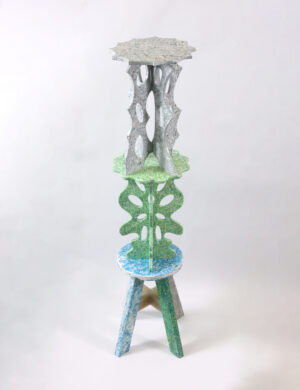Genderloop
Francine Fang
See it On Campus: Level 2
Visitor InfoGenderloop is a series of interactive objects created to encourage people to talk about gender equality.

In our society, we have a certain criterion of genders. We squeeze children into pink or blue box and tell them they have to be certain things. In China, some standards are more crucial, and we even avoid discussing that. How can we achieve gender equality when we don’t talk about that?
Genderloop is a multi-player game created to encourage people to talk about gender equality. When we think of play, most of us think of it as something that’s reserved for children. But adults also love to play. By playing games and letting your guard down, you can share your ideas about gender issues with families, friends or even strangers. There are no right or wrong answers and no lecturing is allowed.
Genderloop includes two games, tags and I should have known that.

Game 1 – Tags
Players divide into two teams. Lighter color represents femininity and darker color represents masculinity. Choose a side of the lid and close it to start the game.
One team says a word that stereotypes female or male, like needy.
The other team considers where it belongs and places a block on that area. If they think it is a neutral word, just place it across two areas.
The team who knocks over loses.
Language shapes the way we think. By giving examples and discussing biased languages and gender stereotypes, we can become aware of unconscious bias and revolutionize our perceptions.
During the game, players can purpose and discuss social and cultural roles of male and female without any burden. Some stereotypes are so firmly embedded in our psyche that even neutral words are towards a particular sex. Realizing those biases is a good start.


The lid has two sides with different patterns
which provides varied gameplay.




Game 2 – I should have know that
Each player in turn rolls the dice. If it is number, just build that number of blocks. If it is a exclamation mark, the player needs to take a dilemma card, read the story, and follow instructions.
The player who knocks over is immediately out and needs to receive a punishment. The last player left in the game wins.


Contents are based on data research and real stories from in-depth interviews with four LGBTQ individuals in China . Reading in the first-person point of view is a way to walk in your counterparts’ shoes, take their perspective, and understand what pressure they face. Sharing laughter and fun can also foster empathy. Empathy has the power to bring us together. It’s an ability to identify with what someone else might be feeling and that connection is what motivates us to treat others the way we want to be treated.



Not only a game, but a decorative object
This game is great for parties, or ice-breaking activities. It doesn’t have to be a formal time set aside for play, it can be at dinner-time, on vacation, at family reunions, holidays, gatherings, special family events or a camping trip.


Take the fun with you wherever you go!






Rules of Play



Curious about how I came up with Genderloop?

Acknowlegements
The design is the result of a year journey, and it wouldn’t have been possible without the support of many people.
A big thank you to my supervisors, Sophie, Keith and Christian and ECU woodshop technitians: Brian, Trevor, Renee, Marty, Joe and Harry and Steven from CNC center. Also deeply grateful to Professor Hong Lin who helped me connect the Chinese LGBTQ community and all interviewees, Piaopiao, Feifei, Qianwen Hu, Wang Liao. Without your stories, I couldn’t complete my card design. I would like to thank all participants involve in the woodshops.
Lastly, I wanna thanks to my family and friends for being so supportive to me through these years.





